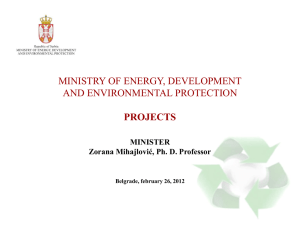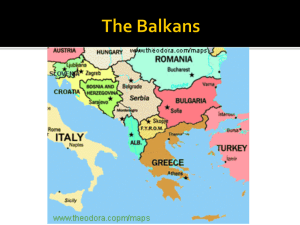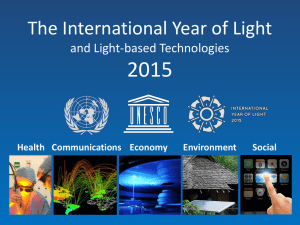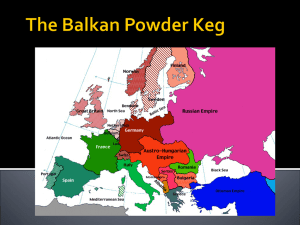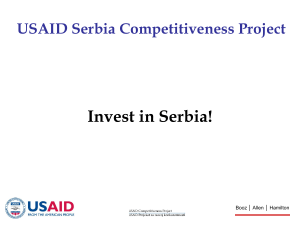Budget Planning training
advertisement
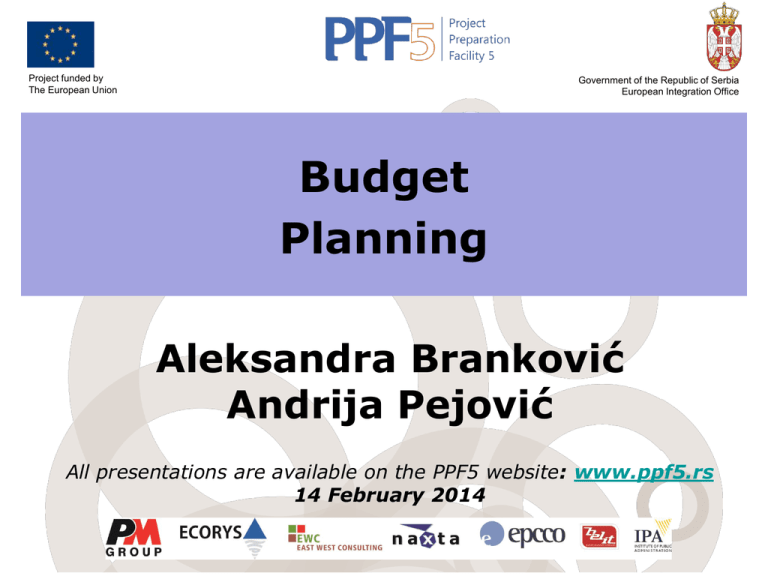
Project funded by The European Union Government of the Republic of Serbia European Integration Office Budget Planning Aleksandra Branković Andrija Pejović All presentations are available on the PPF5 website: www.ppf5.rs 14 February 2014 Hierarchy of Strategic Documents Enlargement Package (EU Enlargement Strategy, EC Progress Report /SAA/ European Partnership) IPA II Regulation / Rules of Application Country /Multi-Country Strategy Paper National Sector Programme or (IPA-specific) Sector Planning Document -SPD) Action Documents (ADs) Annexed: SPDs (Draft) Action Programme (AP) Project funded by The European Union Financing Proposal Annexed: ADs Commission Implementing Decision Annexed: AP Financing Agreement Government of the Republic of Serbia European Integration Office Sector Planning Document SPD Template Purpose Section 1: Sector Description To systematically address the EC criteria for Sector Approach and show that the sector in question is sufficiently mature to adopt a Sector Approach. Also the steps being undertaken to increase sector maturity. 1.4 Mid-term perspectives on national budget and development assitance Section 2: Sector Programme Rationale To provide justification for the proposed programme to explain the focus of IPA assistance within the whole scope of the sector An overall picture of the problems to be solved with the support of IPA funded sector support. Section 3: Sector Programme Description To describe in detail the proposed programme covering: overall /specific objectives; impact indicators; results; measures & operations; institutional arrangements for implementation. Section 4: Budget To provide an indicative 3-year sector budget based on all sources Section 5: Annexes Log Frame Project funded by Institutional The European Union To provide inputs for the associated Action Documents Government of the Republic of Serbia European Integration Office Section 4 Sector Support Programme Budget SOURCES OF FUNDING TOTAL EXPENDIT URE SECTOR TITLE I B ( 1 ) IN V (1 ) EUR (a)=(b)+( e) TOTAL PUBLIC EXPENDIT URE EUR (b)=(c)+( d) IPA CONTRIBUTIO N EUR (c) % (2) NATIONAL PUBLIC CONTRIBUTION Total EUR (d)=(x)+ (y)+(z) % Cent ( ral 2 EUR ) (x) Regional/ Local EUR (y) IFIs EUR (z) PRIVATE CONTRIBU TION EUR (e) % ( 3 ) Priority 1 Measure 1.1. Operation 1.1.1. …. Priority 2 Measure 2.1 Operation 2.1.1. …. TOTAL IB TOTAL INV TOTAL SSP Project funded by The European Union Government of the Republic of Serbia European Integration Office Section 4 Sector Support Programme Budget • Similar to IPA I, budget template for Sector fiche • Standard approach to preparation of budget • Dismantle Measures and Operations to Contracts • Preparing Section 4 and ‘Annex 3: Indicative Implementation Schedule’ in parallel Project funded by The European Union Government of the Republic of Serbia European Integration Office Exercise for today’s session Competitiveness Sector Planning Document (DRAFT!) Specific objective 3: The implementation of the EU-harmonised policies to create a well functioning market economy improved Measure 3.1: Improving the policy, regulatory and institutional framework and implementation capacities of economic operators Project funded by The European Union Government of the Republic of Serbia European Integration Office Keep in mind the following: • PRAG rules/types of contracts • Co-financing requirements • N+ rules • Linkages with national budget planning process Project funded by The European Union Government of the Republic of Serbia European Integration Office Indicative determination of contract value Three approaches • Bottom up • Top down • Mixed Sectoral and priority allocation predefined? Project funded by The European Union Government of the Republic of Serbia European Integration Office How to determine value Service Contract • The budget includes expert fees (which includes the margin or profit for the consulting • company) which are calculated in relation to type and number of experts (see table). • Maximum duration of such project is two years (sometimes three). Project funded by The European Union Government of the Republic of Serbia European Integration Office How to determine value Expert fees Project funded by The European Union Government of the Republic of Serbia European Integration Office How to determine value Other costs: Incidental expenditure (between 2 & 5, sometimes 10% of budget): • Bank charges • Per diems for experts working outside project base of operations (e.g. Belgrade) • Visibility events, translation etc. • Verification (e.g. around 2% of budget for external auditor fees) Project funded by The European Union Government of the Republic of Serbia European Integration Office Types of Contract and Associated Documents IPA Action Document P r o c u r e m e n t SERVICES SUPPLIES Technical Specifications WORKS Bills of Quantity GRANTS Project funded by The European Union Terms of Reference Guidelines for Applicants Government of the Republic of Serbia European Integration Office Service contract-Budget planning-fee based First payment: • for projects up to 12 months: 40% • for projects between 12 and 24 months: 30% • for 24 months projects or longer: 20% Payments during project implementation: • every 6 months in equal amounts. Final payment: 10% Project funded by The European Union Government of the Republic of Serbia European Integration Office Service contract-Budget planning-Global price • First payment : 60% • Payments during project implementation: no payments in most cases, but it depend on the project. If there are payments: 10% every 6 months. • Final payment: 40%. Project funded by The European Union Government of the Republic of Serbia European Integration Office Service contract-Budget planning-Global price • First payment : 60% • Payments during project implementation: no payments in most cases, but it depend on the project. If there are payments: 10% every 6 months. • Final payment: 40%. Project funded by The European Union Government of the Republic of Serbia European Integration Office Supply contract-Budget planning • First payment : 60% • Payments during project implementation: in most of the cases there are no payments. • Final payment: 40% Project funded by The European Union Government of the Republic of Serbia European Integration Office Works contract-Budget planning • First payment: 10% • Payments during project implementation: every month in equal amounts • Final payment: 10% Project funded by The European Union Government of the Republic of Serbia European Integration Office Twinning-Budget planning • First payment: 20% • Payments during project implementation: instalment every three months • Final payment: 5% Project funded by The European Union Government of the Republic of Serbia European Integration Office Grant-Budget planning First payment: 80% Payments during project implementation: 0 if project lasts for 1 year; if project lasts for more than 1 year additional 10% can be added to pre-financing later on during project mplementation. It can be a single payment or 10% can be split up into 5+5% depending on the project duration. Final payment: 20% if project lasts for 1 year; could be 10% if project lasts for longer than 1 year Project funded by The European Union Government of the Republic of Serbia European Integration Office Exercise• Table 1-Operation Budget • Table 2-SPD Section 4 • Table 3-Disbursement Project funded by The European Union Government of the Republic of Serbia European Integration Office EU co-financing framework National co-financing framework Project funded by The European Union Government of the Republic of Serbia European Integration Office Outline of IPA RAP • IPA RAP not adopted yet Financial management a. Eligibility of expenditure; as regards specificity of the policy areas, specific provision may be foreseen in the Financing Agreements. b. The co-financing concept in principle to be maintained. Specific criteria to modulate the cofinancing rate set in the IPA Common Strategic Framework. (to be developed) Detailed level of the EU contribution laid down in the respective Financing Agreements. Project funded by The European Union Government of the Republic of Serbia European Integration Office Outline of IPA RAP Aid intensity and rate of IPA assistance 1. The Commission decision adopting a cooperation programme shall fix the co-financing rate and the maximum amount of IPA assistance, based either on: a) total eligible expenditure, including public and private expenditure; or b) public eligible expenditure. 2. The co-financing rate at the level of each [priority axis] shall not be less than [20 %] and not higher than [85 %] of the eligible expenditure of a cooperation programme. Project funded by The European Union Government of the Republic of Serbia European Integration Office OLD IPA IR Co-financing requirements Institution building activities: require a degree of co-financing by the final beneficiary and/or public funds. Exceptionally and in dully justified cases, activities may be funded 100% by Community funds Administrative co-operation (twinning and TAIEX type of activities) may be funded 100% by Community funds. If twinning is involved, clearly state the expected co-financing budget of the twinning contract. To note that contributions in kind are not eligible. Grants: the final beneficiaries may be required to contribute to the operation’s eligible costs. In general, final beneficiaries must contribute a minimum of 10 percent of the project, both for investment and institution building projects. Project funded by The European Union Government of the Republic of Serbia European Integration Office National framework for co-financing Budget System Law Preparation of budgets and financial plans Article 28 4) Overview of the expected funds from the financial assistance of the European Union; 5) Estimation of the necessary financial resources to fund the participation of the Republic of Serbia in implementing of the financial assistance of the European Union; Project funded by The European Union Government of the Republic of Serbia European Integration Office National framework for co-financing Budget System Law (Article 68a) • Budget users are responsible for proper planning in accordance with agreement between RS and EU, in the proper planning of the amount of expenditure • Budget user who do not funds sufficient funds for co-financing must redirect funds form their other budget lines Project funded by The European Union Government of the Republic of Serbia European Integration Office Budget system Law-Calendar Project funded by The European Union Government of the Republic of Serbia European Integration Office Guidelines for preparation of the Budget • Co-financing can be provided from public funds (by definition EU public funds are funds of budgets, own source revenues , loans granted to the state) or grants from international institutions. • Time frame of planning and implementation of activities that are co-financed by national funds under projects financed by EU funds Project funded by The European Union Government of the Republic of Serbia European Integration Office Time frame It is necessary to respect the following rules : • Activities that are co-financed under the project/sectoral program defines in project proposals/sectoral programs which make annual National program; • The funds for co-financing of projects/sectoral program must be planned in within the allowable budget limits for every budget users; • Bearing in mind that the implementation of the annual IPA perennial and can not coincides with the national budget year , it is the projection plan funds to finance activities that are cofinanced; Project funded by The European Union Government of the Republic of Serbia European Integration Office Time frame • Activities that are considered as co-financing must begin with the realization after the signature of the Financing Agreement. Otherwise, the funds which are financed these activities will not be recognized as part of the co-financing; • National co-financing should be planned taking into account the dynamics of implementation of project/program activities. • When planning the dynamics of negotiation, ie . Payment of those activities co-financed by public funds, or in predicting the resources that are need for co-financing the activities of the project /sectoral program should be take into account the order of activities listed in the project or in the sectoral program; Project funded by The European Union Government of the Republic of Serbia European Integration Office Time frame • Contracts for the implementation of all project/sectoral program must be concluded within two or three years from the date of signature of the Financing agreements depending on which service is provided specific financial Agreement within two years after the conclusion of individual contractscontractual obligations to be performed, and the payment of funds for their implementation is must be completed no later than one year from the last day set for the execution particular contract, unless otherwise specified in the Financing Agreement; • EC must be aware of implementation of part of the project/program activities, are co-financed from national resources; Project funded by The European Union Government of the Republic of Serbia European Integration Office Exercise• Table 4-Instructions for projects financed from EU funds (IPA) Project funded by The European Union Government of the Republic of Serbia European Integration Office N+ Rules OPTION 2 Combined annual Programme (max. 3 years) PROGRAMME ARCHITECTURE OPTION 1 Annual Programme OPTION 3 Multiannual Programme with split commitments (max. 7 years) Financing Decision (FD) Financing Decision covering an allocation for one year. Financing Decision covering an allocation for up to three years with suspension clause. Financing Decision covering an allocation for an initial (maximum) three years with suspension clause. Amendment of Financing Decision to add allocations for consecutive years' budget allocation at least twice. Possibly: Commission Decisions for selection of certain infrastructure projects (major projects) per year. Action Programme (Annex to FD) Action Programme covering Actions programmed for one year or Action Programme covering Actions programmed for more than one year and broken down into annual priorities (=selected Actions). Action Programme covering Actions programmed for three or more years and broken down into priorities for a maximum of three years. For these priorities (selected Actions), it must be clearly identified whether they are financed from year N, N+1 or N+2. Action Programme covering Actions programmed for up to seven years without earmarking of Actions by year. Budgetary commitment One budgetary commitment in year N. Annual budgetary commitments in N, N+1 and N+2 (three). The budgetary commitment is broken down into seven instalments, one for each year (through amendments to original commitment). Financing Agreement Project funded by The European Union One Financing Agreement. Financing Agreements to be concluded for each year or two amendments to original Financing Agreement. Financing Agreements to be signed covering allocations as specified in the Financing Decision (maximum initial allocation of three years) with suspension clause. Amendments to Financing Agreement Government of the Republic to add allocations for consecutive of Serbia years' budget allocation at least European Integration Office N+ Rules Relevant legal framework Article 189(2) FR Article 2 CIR Article 189(2) FR Article 6(3) CIR Article 189(3) FR Article 16 IPA RAP Article 6(3) CIR Possible methods of implementation Direct and Indirect Direct and Indirect Only Indirect IMPLEMENTATION TIMELINE Deadline for conclusion of Financing Agreement Deadline for conclusion of procurement contracts and grant agreements Deadline for operational implementation Deadline for automatic de-commitment Project funded by The European Union N+1 d+3 from conclusion of Financing Agreement “d” the date of conclusion of the Financing Agreement. 6 years from conclusion of Financing Agreement None N+1 counted from the year of creation of each yearly commitment None d+3 from conclusion of each Financing Agreement None 6 years from conclusion of each Financing Agreement None None Each yearly split commitment must be spent within five years of its validation (N+5). The last split commitment Government of the(2020) Republic must be spent within six years of its of Serbia validation (N+6). European Integration Office Sector Budget There needs to be a clear link between sector policy & budgeting. Sector plans should be properly priced & prioritized within a realistic estimate of the resources available from the national budget & external donors. IPA II Sector Support Programmes are planned to be multi-annual & should be co-financed by predictable, multi-annual national funding. It is necessary to provide a brief description of the sector budget on an annual, & if possible, on a medium-term perspective (3-5 years). Ideally there should be a Medium Term Expenditure Framework (MTEF) for the sector. However, development of MTEFs will be gradual, at first assessments should focus on the existence of credible annual sector budgets. At minimum, it is crucial to verify whether the sector budget can be identified in the state budget. Project funded by The European Union Government of the Republic of Serbia European Integration Office Path towards Fully-fledged Sector Support • Can the sector budget be easily identified in the state budget? • What is the nature and scope of the sector budget? • Does the budget fairly reflect the sector policies and objectives? • What type of budget classification system is in use? • What is the overall level of sector financing? • Is the share the sector within total government expenditures increasing? Project funded by The European Union Government of the Republic of Serbia European Integration Office Path towards Fully-fledged Sector Support-MTEF • If a sector MTEF is in place, key assessment questions include: • Is it consistent with declared policies and the national budget/overall MTEF of the country? • Is it approved at a political level or is it largely a technical document? • If a sector MTEF is foreseen by the government how can its elaboration be supported by means of the Sector Support Programme? Project funded by The European Union Government of the Republic of Serbia European Integration Office Path towards Fully-fledged Sector Support-MTEF • If a sector MTEF is in place, key assessment questions include: • Is it consistent with declared policies and the national budget/overall MTEF of the country? • Is it approved at a political level or is it largely a technical document? • If a sector MTEF is foreseen by the government how can its elaboration be supported by means of the Sector Support Programme? Project funded by The European Union Government of the Republic of Serbia European Integration Office Path towards Fully-fledged Sector Support-MTEF • If a sector MTEF is in place, key assessment questions include: • • • • If an MTEF is already in preparation, has a coherent and broad sector development plan with appropriate financing framework at sector and national level been defined/decided at a political level and is it considered feasible and is it consistent with national/overall MTEF? If a Sector MTEF is not in place, are appropriate sector allocations secured and properly stated in the general budget? Is there an on-going process leading to the setting up of Sector MTEF? Based on the analysis, recommendations should be made to the Government. Project funded by The European Union Government of the Republic of Serbia European Integration Office Programatic budgeting Differences between program and line budget: Showing: 1. that the purpose of money is spent; 2. how such consumption is linked to strategic objectives, and 3. what results should be achieved Project funded by The European Union Government of the Republic of Serbia European Integration Office Advantages of programme budget • Provides a single framework for prioritization of expenditures; • Improves policy coordination at the government level, which is crucial for achieving the national, social and economic objectives; • Provides financial context of strategic and operational plans for budget users; Project funded by The European Union Government of the Republic of Serbia European Integration Office Advantages of programme budget • Allows the government and local authorities to identify inefficient spending, as well as areas that do not provide adequate results and that require more resources; • Contributes to the improvement of public administration services through the evaluation of the relationship of their price and quality; • Makes budget more transparent and understandable for citizens Project funded by The European Union Government of the Republic of Serbia European Integration Office Programme budget • The introduction of program budgeting is of major importance for the improvement of public finance, as it enables continuous multiyear financing of priority policies, programs and projects. • • • By the end of 2013 a comprehensive preparation of institutions has been conducted for the introduction of program budgeting. By the end of 2013, fourteen (14) Serbian intuitions have adopted program based budget, including SEIO. During 2014, the preparation of institutions for the introduction of program budgeting will continue, as it is planned for the 2015 budget year according to the Budget System Law. Project funded by The European Union Government of the Republic of Serbia European Integration Office Mid-Term Expenditure Frameworks (MTEF) • Mid-Term Expenditure Frameworks (MTEFs) are part of the existing Fiscal Strategy. They are determined at the level of budget users and cannot directly be transformed into sector MTEFs. • Recently adopted legislation requires the merging of strategic planning of public policies with the budget process within the government and the parliament. This will include mandatory three-year budget planning and the introduction of programme budgeting by 2015. • It is planned that MTEFs for sectors will be developed alongside programme budgeting. For this to be feasible it will be necessary to ensure correspondence between the budget programmes and the NAD sectors. Project funded by The European Union Government of the Republic of Serbia European Integration Office Strategic Planning and Coordination of Public Policies • The guidelines for drafting the strategic documents were provided in the form of recommendations, and the uniform information system was introduced for the collection of data required for the government work program. • Draft Methodology for Integrated Strategic Planning was prepared, and this draft is to be adopted. • Still, upgrading of strategic planning and coordination of public policies within the Government should be considered the priority task in the forthcoming public administration reform process. Project funded by The European Union Government of the Republic of Serbia European Integration Office Project funded by The European Union Government of the Republic of Serbia European Integration Office Thank you for your attention All presentations are available on the PPF5 website: www.ppf5.rs

